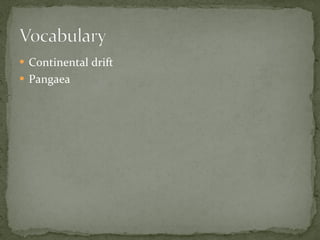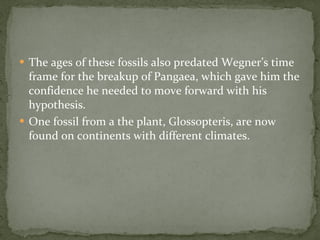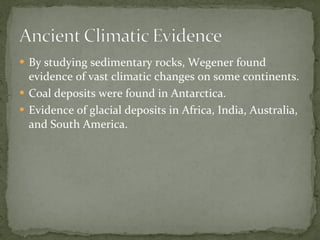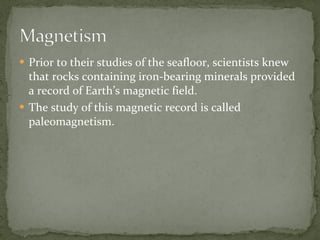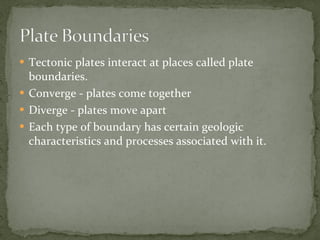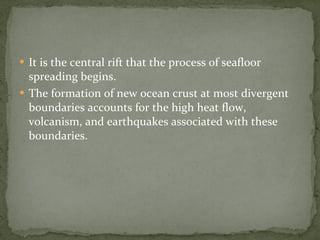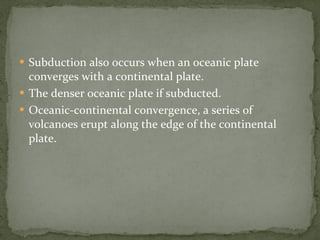Plate tectonics
- 2. Describe one piece of early evidence that led people to suggest that Earth’s continents may have once been joined. Discuss evidence of continental drift. Explain why continental drift was not accepted when it was first proposed.
- 4. Earth’s surface appears to remain relatively unchanged during the course of an average human lifetime. On the geologic time scale, however, Earth’s surface is changing at rates almost too great to imagine.
- 5. South America is moving away from Africa at a rate of 2 to 3 cm/y. The volcanic islands that make up Hawaii are migrating toward the northwest at a rate of 8 to 9 cm/y. Mt. Everest is slowly rising. What could be causing such enormous pieces of land to move?
- 6. In the late 1500’s, Abraham Ortelius, a Dutch mapmaker, noticed the apparent fit of continents on either side of the Atlantic Ocean. Many others noticed the matching coastlines. The first time that the idea of moving continents was proposed as a serious scientific hypothesis occurred in the early 1900’s
- 7. Alfred Wegener called his hypothesis continental drift, which proposed that Earth’s continents had once been joined as a single landmass. He called this super continent Pangaea, a Greek word that means “all the Earth”.
- 8. Wegener was one of the first supporters of the concept of drifting continents to base his hypothesis on more than just the puzzle like fit of continental coastlines on either side of the Atlantic. He also collected and organized rock, fossil, and climatic data to support his hypothesis.
- 9. Wegener hypothesized that there should be areas of similar rock types on both sides of the Atlantic. Some of the rocks of the Appalachian Mountains in the US shared similar features with rocks in Greenland and Europe. These rocks are 200 million years old.
- 10. Similar fossils of several different animals and plants that once lived on land had been found on widely separated continents. Wegener reasoned that the land-dwelling animals could not have swum the great distances that now exist between continents.
- 11. The ages of these fossils also predated Wegner’s time frame for the breakup of Pangaea, which gave him the confidence he needed to move forward with his hypothesis. One fossil from a the plant, Glossopteris, are now found on continents with different climates.
- 12. By studying sedimentary rocks, Wegener found evidence of vast climatic changes on some continents. Coal deposits were found in Antarctica. Evidence of glacial deposits in Africa, India, Australia, and South America.
- 13. Because the south pole is not presently located near Africa or India, Wegener suggested two possibilities to explain glacial deposits: The pole had shifted its position Landmasses had drifted away from the pole The later seemed bore plausible.
- 14. In the early 1900’s, many people in the scientific community strongly believed that the continents and ocean basins were permanent, fixed features of Earth’s surface. Most scientist of his time rejected his theory even with evidence.
- 15. His hypothesis had two major flaws: Could not satisfactorily explain what was causing the continents to move. Scientist also had questions about how the continents were moving.
- 16. Wegner did not give up when his hypothesis was not accepted by most other scientists. He died in the 1930’s but the process that could explain why and how the continents move was not found until the 1960’s.
- 18. Summarize the evidence that led to the discovery of seafloor spreading. Explain the significance of magnetic patterns on the seafloor. Explain the process of seafloor spreading.
- 19. Magnetometer Paleomagnetism Magnetic reversal Isochron Seafloor spreading
- 20. Until the mid-1900’s, most people, including many scientists thought the ocean floor, unlike the continents, was essentially flat. People thought that the oceanic floor was unchanging and older than continental crust. Technology in the 40’s and 50’s proved all of these accepted ideas wrong.
- 21. Sonar - uses sound waves to measure water depth. Sound waves travel through the water and are reflected from the ocean floor. The time is calculated into a distance.
- 22. A magnetometer is a device that can detect small changes in magnetic fields. The measurements are then used to construct magnetic maps of the seafloor.
- 23. The maps made from the data collected by sonar and magnetometers surprised many scientists. Underwater mountain chains called ocean ridges were discovered. They are the longest continual mountain range on Earth.
- 24. Discovered that earthquakes and volcanism are common along the ridges. deep-sea trenches were also found Deep-sea trench is a narrow, elongated depression in the seafloor with very steep sides. Very long and are extremely deep
- 25. These two topographic features of the ocean floor - deep-sea trenches and ocean ridges - puzzled geologists for over a decade after their discovery.
- 26. Scientist began to analyze samples of deep-sea sediments Analysis of the rocks and sediments produced two important discoveries. First, ages of the rocks that make up the seafloor vary in different places Second discovery, measurements showed the thickness of ocean-floor sediment is much less than expected
- 27. Ocean floor sediment are typically a few hundred meters thick. Careful observation of ocean-floor sediments also revealed that the thickness of the sediments increases with distance from an ocean ridge.
- 28. Prior to their studies of the seafloor, scientists knew that rocks containing iron-bearing minerals provided a record of Earth’s magnetic field. The study of this magnetic record is called paleomagnetism.
- 29. Studies over time revealed a pattern of magnetic reversals over geologic time. A magnetic reversal is a change in Earth’s magnetic field. A magnetic field that has the same orientation as Earth’s present field is said to have normal polarity. Amagnetic field that is opposite to the present field has reversed polarity
- 30. To find out how the continental basalt-flow data compared with the basalts that make up the ocean floor, scientists proposed that magnetometers be towed behind ships to measure the magnetic field of the ocean floor. A pattern emerged as seen on page 451.
- 31. “ Theory of Plate Tectonics”
- 32. Explain the theory of plate tectonics. Compare and contrast the three types of plate boundaries and the features associated with each.
- 33. Theory of plate tectonics Divergent boundary Rift valley Convergent boundary Subduction Transform boundary
- 34. Theory of plate tectonics - states that Earth’s crust and rigid upper mantle are broken into enormous slabs called plates. Tectonic plates move in different directions and at different rates over Earth’s surface.
- 35. Tectonic plates interact at places called plate boundaries. Converge - plates come together Diverge - plates move apart Each type of boundary has certain geologic characteristics and processes associated with it.
- 36. Places where two tectonic plates are moving apart are called divergent boundaries. Found mostly on the seafloor, where they form ocean ridges. This plate boundary is located in a rift, or fault-bounded valley.
- 37. It is the central rift that the process of seafloor spreading begins. The formation of new ocean crust at most divergent boundaries accounts for the high heat flow, volcanism, and earthquakes associated with these boundaries.
- 38. The growth of the Atlantic Ocean is about 2 to 3 cm/y. Some divergent boundaries form on continents When continental crust begins to separate, the stretched crust forms a long, narrow depression called a rift valley. Ex. East Africa
- 39. Places where two tectonics plates are moving toward each other are convergent boundaries. Three types of convergent boundaries Oceanic crust converging w/ oceanic crust Oceanic crust converging w/ continental Continental crust converging w/ continental
- 40. Subduction - one of the two plates is descending beneath the other in a process called subduction. A subduction zone forms when one oceanic plate, which has become denser as a result of cooling, descends below another plate.
- 41. The process of subduction creates a deep-sea trench. Some of the magma that forms is forced back to the surface, erupts, and forms an arc of volcanic islands that parallel the trench.
- 42. Subduction also occurs when an oceanic plate converges with a continental plate. The denser oceanic plate if subducted. Oceanic-continental convergence, a series of volcanoes erupt along the edge of the continental plate.
- 43. The result of this type of subduction is a mountain range with many volcanoes. The third type of convergent boundary forms when two continental plates collide. This convergent boundary forms when two continental plates collide.
- 44. A place where two plates slide horizontally past each other is a transform boundary. At transform boundaries crust is only deformed or fractured. Transform boundaries are characterized by long faults, sometimes hundreds of kilometers in length, and by shallow earthquakes. Rarely found on continents. San Andreas is the best-know exception.
- 45. This convergent boundary forms when an ocean basin between converging oceanic and continental platesis entirely subducted. One continent is pulled into the subduction zone, but it can’t be subducted because continental rocks are too buoyant to by forced into the mantle. The crust then crumples and uplifts to form mountains.


